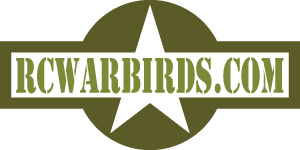 |
Lt. Colonel Monroe Williams flew P-47's and Mustangs from Raydon, a base in England during WWII. He flew ground seek and destroy missions and you may have seen gun camera footage of Monroe shooting up a train on the History channel.
I am lucky to have met Monroe via email while working on a game called Jane's Attack Squadron. I was working on a virtual paint job of his P-47 called "Willie the Wolf" for the P-47 in the game.
Here are some notes from Monroe to me about his plane and his missions.
|
|
Biography
MONROE Q. WILLIAMS was born on Oct.21, 1921 and raised on a cotton farm near the small town of Baldwyn, Miss. I graduated from Baldwyn High in 1940 and was awarded a foot ball scholarship at East Central Jr. College, Decatur Miss. Because of a broken shoulder in training, I left college and joined the CCC ( civilian conservation corp). Spent seven months at Camp Rainier, Wash and was ask to return to college on the scholarship.
In the summer of 1942, after completing one year of college, I was notified that I would be drafted in the fall. I was drafted into the Army Air Corp in October and, after basic training in Miami Beach, Fla., was assigned to Aircraft Mechanic school in Amarillo, Texas.
During my training, I applied and qualified for cadets. Three days after graduation I was on my way to San Antonio for preflight. Primary was at Corsicana,Texas; Basic was at Greenville,Texas and Advance was at Eagle Pass, Texas , Graduating Jan 7, 1944 with class 44A.
After ten hours of P-40 transition training at Moultre Ga, I was on my way to Richmond, Va. for training in the P-47. On June 25, I sailed on the Queen Mary to England. After a brief stay at Atcham, I was assigned to the 351st Ftr Sq. of the 353rd Ftr Gp, arriving July 30, 1944.
During my tour, we flew P-47 aircraft, primarily dive bombing and strafing up through France, and southern Germany in support of the ground troops. During the first part of October, we changed to P-51 aircraft, primarily for long range escort of the bombers. I flew 63 missions (270 combat hours) and was credited with one Me 109 destroyed.
Upon my return from England in April 1945, I was assigned as production control officer at Eglin Air Proving Ground, Fla. After that, I was assigned as Aircraft Engineering Officer with 10th Airforce Hq, Offutt AFB, Omaha, Neb. After SAC moved us off Offutt in 1948, I volunteered to go to the Berlin Airlift at Rhine Maine, Frankfurt, Germany as an Engineering Officer/Pilot. After the Airlift, I remained in Germany, as a line pilot, with the 10th Troop carrier Squadron, flying C-82 aircraft.
Upon my return from Germany, I was assigned to the 3499th Mobile Training Group, Chanute AFB, Ill as a Mobile Training Detachment Commander. While there, I was selected, along with two other officers, three GS civilians, and three ranking NCOs, to plan, service test, and implement a new Field Training Concept for the Air Force. This resulted in the organization of a Field Training Wing with two Field Training Groups.
In 1959, the Field Training organization moved to Amarillo, Texas and became a part of the Amarillo Tech Training Center. In 1962, I became the Director of the Dept. Of Aircraft Training and remained so till my retirement, as a Lt/Col, on Feb. 28, 1965.
After retirement, I became a District Representative for Lutheran Brotherhood Insurance and served for 22 years, retiring Jan 1, 1987.
Now, at age 83, I am back flying P-47s and P-51s in Virtual combat on Janes ww2 Fighter and Forgotten Battles simulators. Also serve as Historical Advisor on http://www.rcwarbirds.com/ website |
Mission notes from Monroe |
Monroe, tell me about one of your favorite missions?
"First, I want to thank you fellows for working on this....as you may know, it brings back a lot of memories for me to re-hash some of these things. Please remember it's been almost 60 years.....but I'll do my best."
"We flew to the target area in formation....took off formed up and climbed out in close formation till we got near enemy territory, spread out into combat formation, and flew to the target area. The mission generally was a mission of opportunity....as we use to say, "shoot anything that's not grown to the ground". Flights would break off and seek targets in our general target area. Usually we would withdraw at the same time and head home in formation. The three numbers are for Destroyed--possible destroyed --damaged -a/d is airdrome 1-0-0 t/e a/c( ground ) is 1 twin-engine aircraft destroyed on ground. Do as you like about putting details in about the other flights....( I see some of them did better than we did in white flight....Not unusual, I was no hero ) I believe I would put in the overall results of the squadron as listed in H. ( Hey look, I see we got 5 trucks that day and I got 4 of them ) As I remember, the train was parked in a freight yard and don't remember any other trains. I have a video clip of my shots and don't see another train. Generally the freight yards were surrounded with ground fire but I don't see any tracers coming at me in this one. No enemy aircraft were encountered on this mission."
Did you use drop tanks and what bombs did you carry?
"Yes, we just about always used drop tanks, usually under the wings. I believe they were a plain metal silver color. I'm just not sure what size but I think they were a 50 gal under each wing. With the P-47, on dive bombing and strafing missions we would also carry a 500 lb bomb under the belly. Or, sometimes if we were using fragmentation bombs against ground troops we may carry a bundle of frag bombs under each wing and a fuel tank under the belly. I could be wrong on the 50 gal......not sure, could be more."
Tell me more about this mission?
"Actual mission report for Aug 27th, 1944. I remember this mission very well. I was flying Col. Ben Rimerman's wing that day. As the Group Commander, he was using the 351st Squadron as the lead Squadron, The lead flight is always White Flight, so I was flying White two. Our mission was dive bombing and strafing in an area just west of Metz. As you will note, my flight missed with all of our 8 500 lb bombs, but we destroyed the train by strafing. Then at the very bottom of the page you will see where 4 trucks were destroyed by Lt Williams and 2 Me109s were destroyed, one by Col. Rimerman and one by Lt. Williams. So , all in all , you can see the Squadron had a pretty good day. Sorry for the poor copy, it was taken from microfilm from the Archives in Maxwell field Ala."
|
|
|
Monroe on Bombing and Strafing
What is the procedure for dive bombing a train or other ground target?
"For dive bombing, we did it from a steep angle...maybe a 75 to 80 degree angle. We would fly almost over the target, do a wingover, line up with the target, reduce power , and as we pull the sight through the target, release the bombs, and pull up sharply increasing power. Be careful to start pull up soon to keep from going into the ground or from getting your own bomb blast. We had pilots killed by their own bomb blast from going too low over the blast area."
And strafing a train or other ground target?
"In our strafing runs, we went in at a lower angle ...maybe about 20 to 30 degrees....high enough so you can see your target but low enough to give the ground gunners less time to target you. As I remember, we left our throttle at regular cruise speed for the run but, after firing , went to full power and peeled out to the right or left. Looking at my clips, looks like I almost always peeled up to the left. I don't know if these procedures will work well in cfs3. I know, in Janes ww2, I seem to be more accurate if I reduce throttle in a strafing run." |
|
Monroe on the new flight sim Combat Flight Simulator 3 by Microsoft
How do you like CFS3 so far Monroe?
"I am finding it a little hard to master this cfs 3. I did find the pop-up instruments under the "HUD" , F5 key. Makes it a little more interesting. I am having problems getting my Joy stick set up like I want it. About all I have done is fly local around Raydon, shooting landings and doing a little Dogfighting. Guess I am still hooked on Janes WW2 Fighters and tend to compare every other Sim to it. I think the planes in cfs3 fly great.....maybe a little underpowered. The engine sounds in the P-47 D and P-51D-25 are not exactly correct....especially the P-51D-25. I think they used the sounds of the P-51B in the P-51D-25. I don't think they are the same...I think the D-25 has more horsepower. Anyway, the sound is too muffled for a P-51.
Though everything is not perfect, I'm not ready to pass judgment on the Sim. I do like flying that area during that time period because that is where I was and what I was doing at that time. So, I'm sure I will keep the sim on my computer."
Do you find the country around Raydon and the base itself to be representative of what it really was?
"As I remember, I would say it is pretty well representative of the area. The layout of the area is very good...Raydon Air field is in the correct spot, just north east of Colchester....between Colchester and Ipswich. The 56th Fighter Group Field, Zemke's famous outfit, is in the correct spot, just North of Colchester. The base, it's self, is not very representative of our base. We had a very nice looking base with three good "hardsurface" runways. I note that the 56th base at Boxted looks much nicer than ours. I have attached a drawing of our base...so you can see the sim didn't represent us very well. But, it is still fun to set that Jug down there again. As you will note, the north side of the field is at the bottom. My squadron, 351st, was on that side of the field. You will note the circles on the taxi way....those are hardstands where our planes were parked. We took off on the South West runway...one of the other squadrons took off to the west...the other took off to the north. That expedited take-off and form-up." |
|
On flightsims in general
Are the flight models in most games realistic?
"I have never understood why Sim developers think, if you do a 360 degree turn in a steep bank, you are suppose to stall out, flip into a flat spin, and crash. I think this may be a factor in the pilots coming from IL2 not liking the planes in cfs 3. I have flown with the 353rd Virtual Fighter Group for about two and half years. When IL2 came out, most of the 25 pilots moved over to IL2. I preferred to stay in Janes WW2 and fly American planes. On occasion , some of the pilots come back to Janes to fly with me.....They find it weird and different. So, if you fly the "harder to fly" , "Easy to stall and spin", type Aircraft , it becomes the norm. But, THAT DOES NOT MEAN THEY ARE REALISTIC. These planes are much more stable than that. In 22 years of flying Airforce planes, I never personally knew of one plane that went into a flat spin."
|
| More notes from Monroe about his fellow pilots
Who are some of the men you flew with?
"Paul, these are the pilots I remember flying with the most. Jack Terzain with his plane MARTY was shot down before I got there.Thanks >>>Monroe "
YJ-L Lt/col Fred Lefebre Chief Wahoo
YJ-V Maj. Vic Byers HawkEye
YJ-O Maj. Gordon Compton Big Bouncer
YJ-D Capt. Lloyd Halley Angel of Mercy
YJ-E Capt Frank Emory SIS
YJ-H Capt. Raymond Hartley KU
YJ-A Capt. Harry D. Milligan Carolene
YJ-M Capt. William J. "Mickey" Maguire Boston Bull
YJ-G Capt. Hassel D. Stump Squirt
YJ-P Lt. William G. Cobb Trisha
YJ-R Lt. Charles L. Mcgraw Liberty Queen
YJ-K Capt. William K. Lahke Janny M
? Lt Howard P. Maree LIBERTY RUN
YJ-E Lt. John W. Bishop Patricia Baby
YJ-B Lt. Albert W. ( Bill ) Barlow Flak Bait
|
| 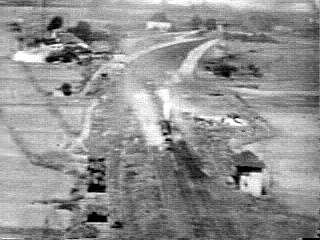
|
Gun Camera Footage of Monroe attacking a train. |
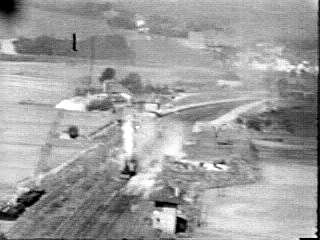 |
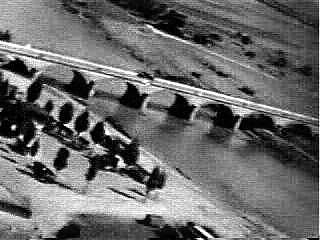 |
Gun Camera Footage of Monroe attacking a truck. |
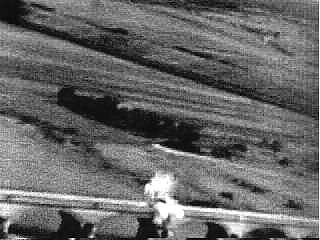 |
Monroe still flies his P-47 and Mustang in the virtual skies of a game called Jane's WWII Fighters. He flies on line against anyone that wants to get shot down.
|
BACK to ADVISORS
|
|
Become an RCWarbrids site supporter by making a donation.
|
$5.00 |
 |
$10.00 |
 |
$15.00 |
 |
$20.00 |
 |
| |
|
|
|
|
